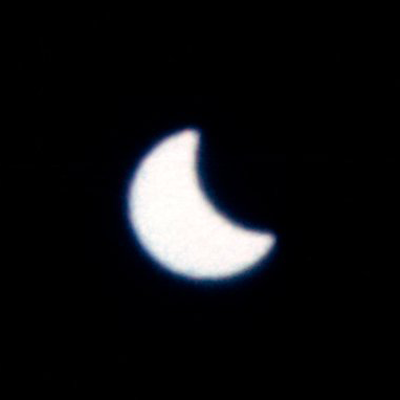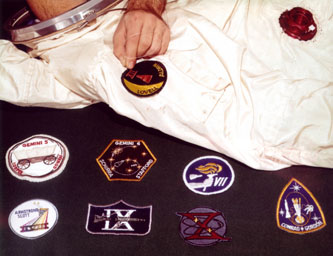

James Lovell
Edwin “Buzz” Aldrin
James Lovell
Anthony Tharenos

The Roman numeral XII is located at the 12 o’clock position as on the
 face of a clock or sundial, with the Gemini spacecraft pointing to it like the
hour hand of a clock pointing to midnight — highlighting Gemini
12’s position as the last flight of the Gemini program.
face of a clock or sundial, with the Gemini spacecraft pointing to it like the
hour hand of a clock pointing to midnight — highlighting Gemini
12’s position as the last flight of the Gemini program.
The designer of the patch, Anthony Tharenos, recalls that the crescent was related to the potential of observing an eclipse during the flight. Ken Young, a redezvous expert in the Mission Planning and Analysis Division (MPAD), recalled: “on that flight we flew through a total solar eclipse ... me and Ed Lineberry figured out how to do it. It was pretty tricky: they had like an 8-second window to fly through the path of the eclipse. Buzz got a real good shot of [it]. That was a rendezvous with a shadow. That was a true phantom rendezvous.” According to the Gemini 12 Mission Report: “... the crew reported that they had passed through the total eclipse starting at 16:01:44 g.e.t. According to postflight calculations, the spacecraft passed within about three nautical miles of the center of the 15-nautical-mile-radius umbra core.” While a solar filter had been provided for the purpose, a telephoto lens had not been, and so the images show just a miniscule crescent — only enough really, to prove it had been done.
Lovell’s recollection of the design, as related by Lattimer, describes the crescent as representing the moon and thus implying a transition from the end of the Gemini program to the Apollo lunar program. But an even more persuasive interpretation is that the sun, emerging from eclipse, represents that transition to the sun god Apollo. Consider that Lovell’s Apollo 13 patch used the sun to represent Apollo.
The original schedule had Gemini 12 flying at Halloween, so the color scheme is black and orange in recognition of the season.
The patch was worn
 on the right shoulder of the pressure suit, which apparently raised the
ire of NASA management. Ed Hengeveld observes that:
on the right shoulder of the pressure suit, which apparently raised the
ire of NASA management. Ed Hengeveld observes that:
In a December 1966 note to Deke Slayton, NASA public affairs chief Julian Scheer reported that Administrator Jim Webb had noticed in Gemini 12 film footage that the “Cooper patch” (mission insignia) was worn on the shoulder, not the right breast as Webb had directed in an August 1965 memo to Gemini 5 command pilot Gordon Cooper. Scheer wanted to know if there were plans “to change from breasts to shoulders.” Slayton passed this message on to the Apollo flight crews in training at that time. The copy of the memo I have has a written comment by ‘T.P.S.’ (Tom Stafford), which reads: “I like breast myself.” To which John Young added: “I’m a leg man.”

NASA Photo 66-HC-1855
This NASA photograph shows the complete set of Gemini patches, with
the final mission patch being sewn onto one of the crew pressure suits.
Things to note: the Gemini 5 patch is clearly the largest, while the
other round patches are relatively small; the Gemini 6A patch is the
“Gemini 6” version rather than the GTA-6 version in the
official NASA photo of the mission patch; the shape of the
Gemini IX patch — nearly flat on the
bottom, and high on the sides — not quite matching the artwork.